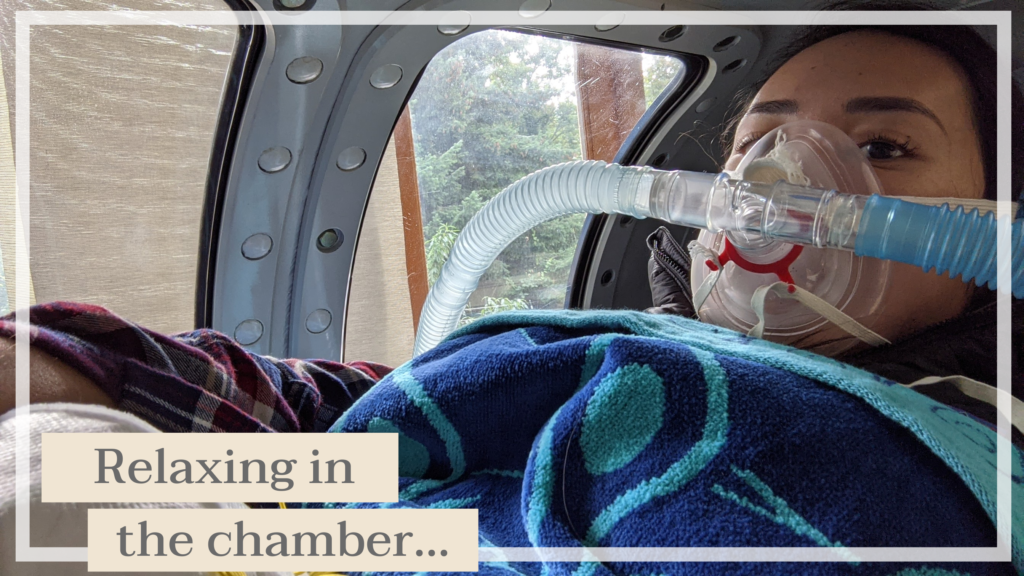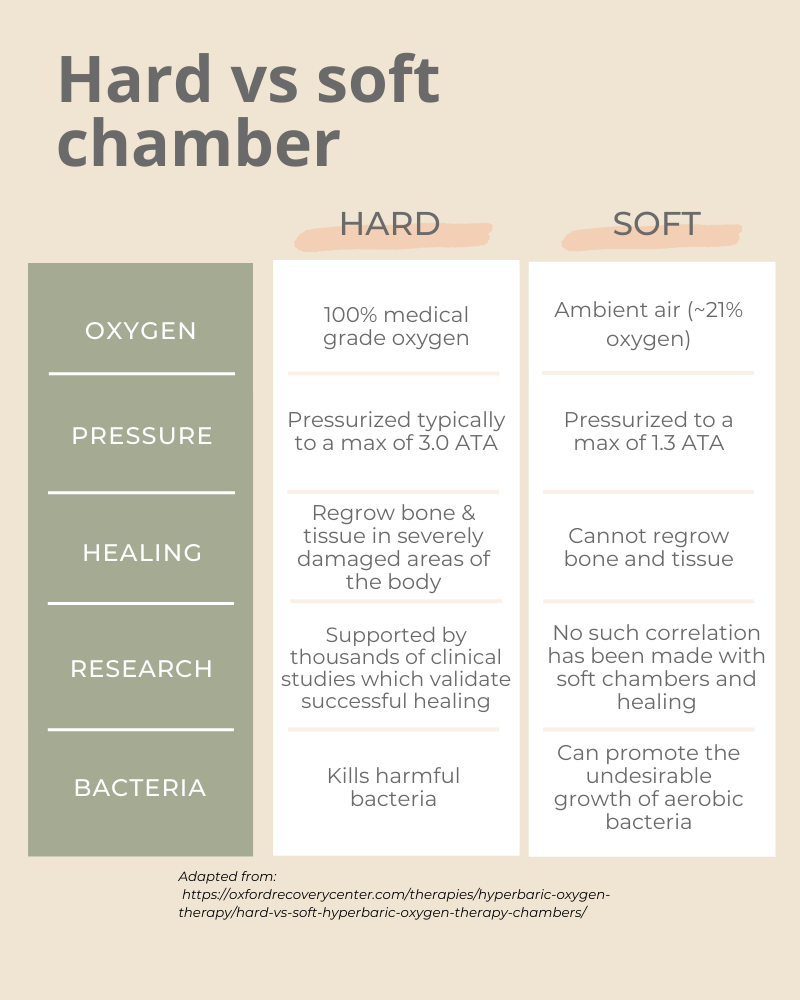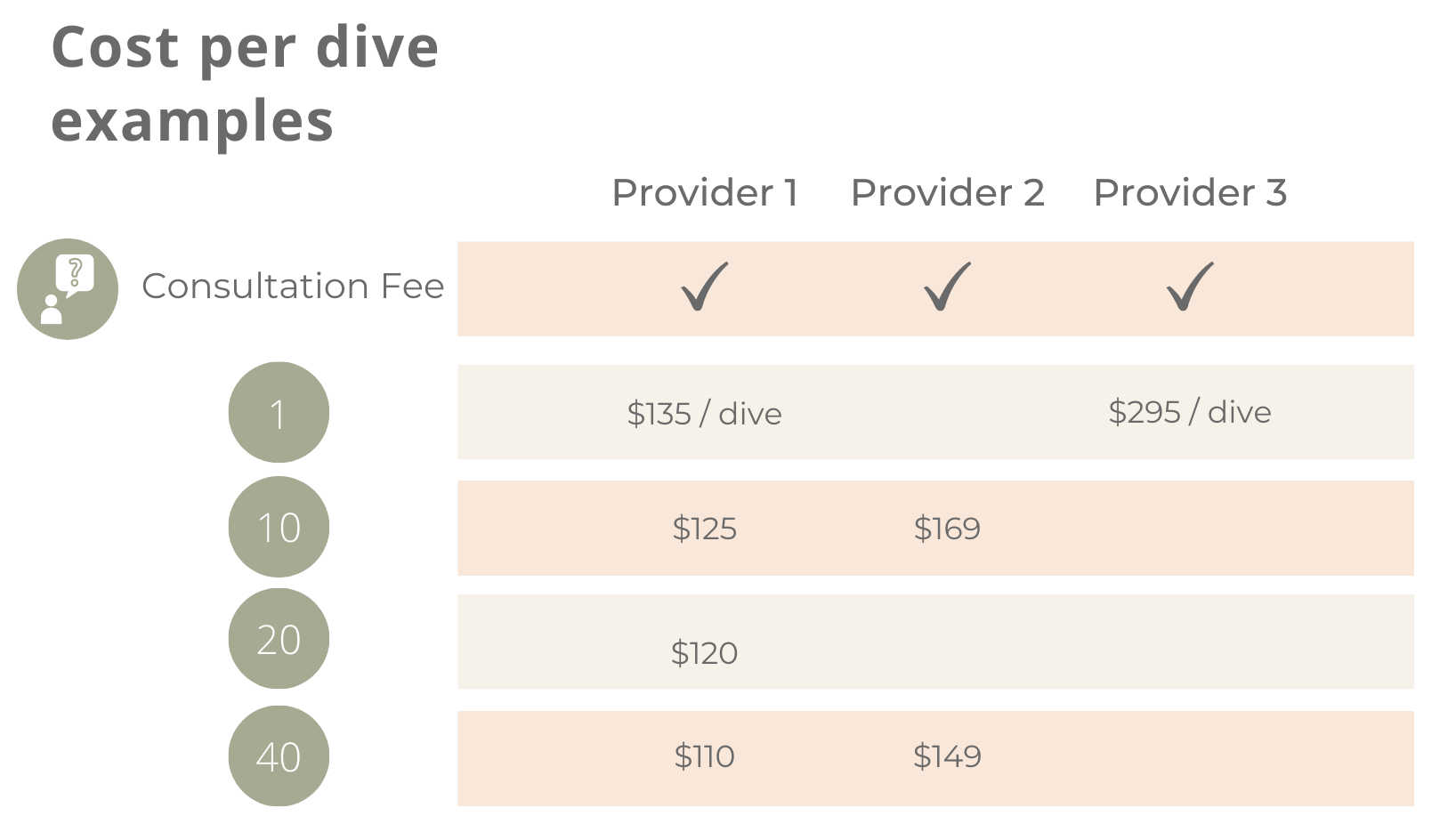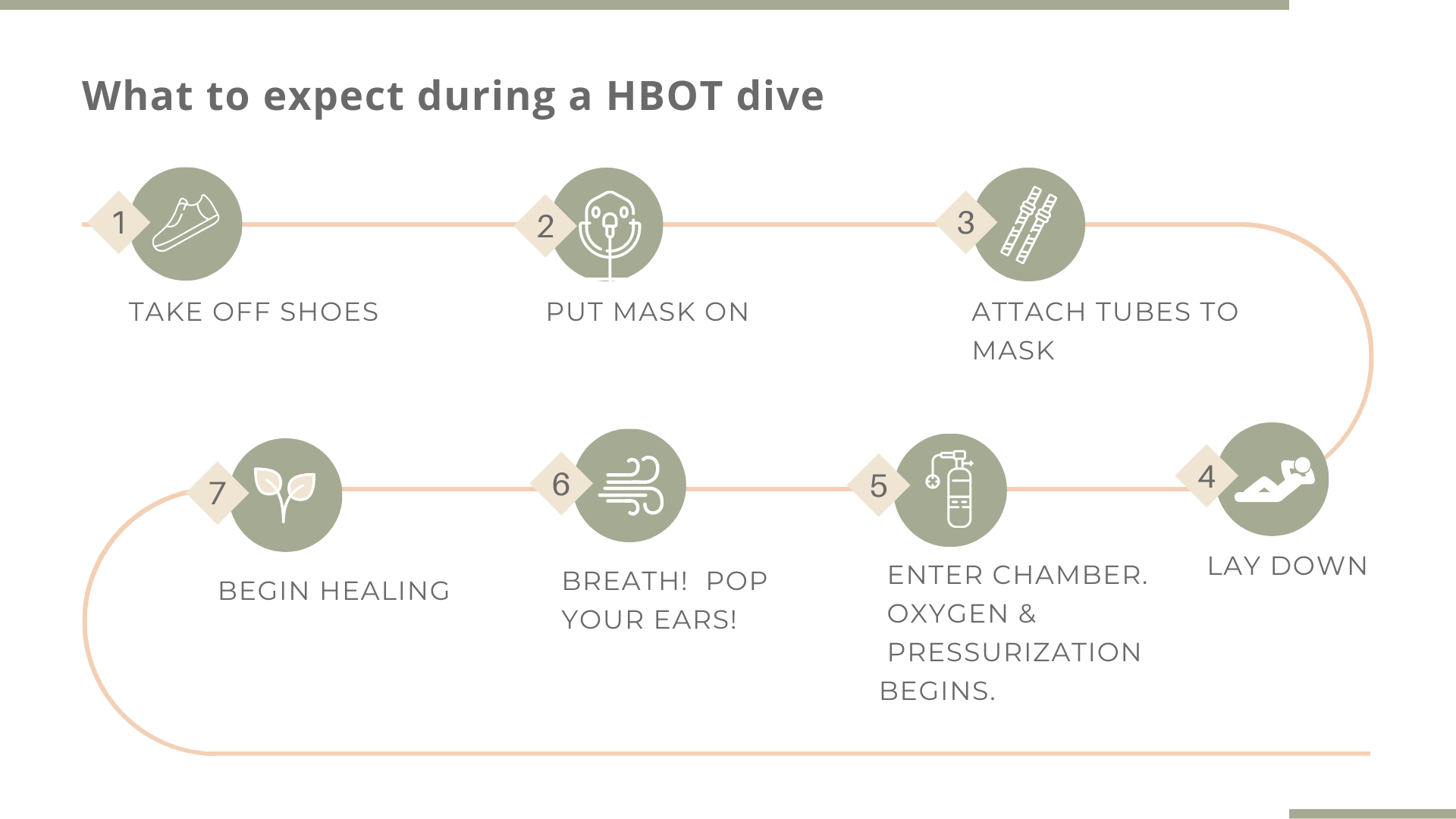Taking deep breaths has numerous benefits for our bodies and minds. From decreasing stress, relieving pain, and boosting the immune system, its such an easy and important way for us to replenish ourselves! It always feels so good to just step outside for a walk (especially in the crisp Fall weather — my favorite!) So, when I first heard about hyperbaric oxygen therapy as a potential Lyme treatment, I was immediately drawn to it. Just breathing? And no needles? Bonus!
What is hyperbaric oxygen therapy?
The goal of hyperbaric oxygen therapy (HBOT) is to increase the amount of oxygen your blood carries, which is then delivered to all parts of the body. The concentrated oxygen gets deep into the tissues and blood, and oxygen promotes tissue repair, healing, and assists in fighting infection by killing viruses and disabling the toxins of certain bacteria. If you’re also taking vitamins and supplements, HBOT boosts the impact of the nutrients because it drives it further into your tissues.
The therapy involves inhaling 100% oxygen in a pressurized chamber, which is one of the fundamental aspects of the therapy. It is the pressurization that increases the amount of oxygen your blood can absorb, a benefit that going to an oxygen bar will not provide.
HBOT is used for many conditions — many covered by insurance, but many not (typical for Lyme…) Some of the on-label conditions, which are potentially covered by insurance, that are treated by HBOT include:
- Carbon monoxide poisoning and smoke inhalation
- Crush injuries
- Decompression sickness
- Failed skin grafts and flaps
- Necrotizing infections
- Radiation tissue damage
- Nonhealing wounds
- Thermal burns
And some off-label conditions include:
- Arthritis
- Cancer
- Chronic fatigue syndrome
- Fibromyalgia
- Lyme disease (The bacteria associated with Lyme disease is anaerobic—it cannot exist in oxygen!)
- Migraine
- Mold toxicity
Fun fact: Did you know HBOT also improves your skin health?! Increased circulation to the skin promotes cell repair, reduces age spots, saggy skin, and wrinkles. What a bonus!

What is the difference between a soft-sided and hard-sided chamber?
There are two types of HBOT chambers: soft-sided and hard-sided. It seems more common to find soft-sided chambers being offered over hard-chambers. The HBOT chamber is pressurized, so a harder chamber translates to the ability to achieve a higher level of pressurization. Soft chambers can only be pressurized to about 1.3 ATA (atmosphere absolute) which corresponds to about 9.9 feet of depth, while hard chambers can reach 3.0 ATA, or about 66 feet of depth.
Low pressure levels unfortunately cannot facilitate as much healing. There are specific situations where a soft chamber would be beneficial, such as for helping with allergies, but a high pressure is needed to heal tissues and kill harmful bacteria.
In addition to the pressure level, a soft chamber is only able to deliver ambient air, which is around 21% oxygen, whereas a hard chamber has the ability to deliver 100% medical-grade oxygen.

Why do some hyperbaric oxygen therapy chambers require patients to wear a mask, but some do not?
The chamber can be pressurized by either the 100% oxygen, or with outside, ambient air. If pressurized with the oxygen, no mask needs to be worn. However, there are additional precautions that must be taken in this case, such as wearing special clothing, and there is an increased risk of oxygen toxicity.
How often do I need to go? How long is each ‘dive’?
Your doctor will ultimately be prescribing the frequency of each ‘dive’, and the duration each time. For Lyme, at least one round of 20 dives is usually prescribed, likely reaching 2.5-3.0 ATA towards your later dives after you have ramped up.
Dives can be 60, 90 or 120 minutes. There is no set standard for Lyme treatment, but it is common to complete 60-minute dives. My HBOT doctor recommended that I consider longer dives, ultimately reducing my total number of dives, but maintaining the same total number of hours. However, my Lyme doctor brought up a concern of the possibility of increased herxing with 120-minute dives, so I instead opted for 90-minute dives as a compromise.
Oxygen toxicity is a potential side effect, especially with longer dives (90 or 120 minutes). To reduce this risk, breaks of 10 or 15 minutes need to be taken mid-dive.
The healing benefits of HBOT are best realized with frequent dives, going as many days during the week as possible. My doctor recommended 3 times a week at a minimum, however, because of my availability, I was able to go 6 times a week. While everyone’s treatment protocol is different, see how I ramped up in my first round of dives:

What are the risks?
As mentioned above, oxygen toxicity is a risk. Other high severity risks include: lung damage, rupture of eardrum, and changes in vision. However, side effects are generally mild, such as fatigue and lightheadedness, if the dive is not longer than two hours, your doctor ramps you up gradually, and gives you breaks if needed.
How much does it cost?
I contacted clinics in the greater Seattle area, specifically looking for one that offered a hard chamber. Of the three that I found, costs widely varied. However, all offer packages of dives. The more you purchase, the cheaper per dive. All charged a consultation fee ranging from $100-$150, unless you had a referral from your physician. The below details the costs for the providers I contacted.

What should I expect during the treatment?
Even though HBOT is a safe treatment, I was a bit nervous. My Lyme doctor told me about how some patients with congested sinuses can experience an intense discomfort, sometimes feeling like their teeth will explode. Woah. Obviously no explosions will actually occur, but yikes. My fears were pretty unwarranted though, my experience was perfectly uneventful!
Before you get started, your doctor/technician will fit you with a mask. I personally had two choices of masks: one that was pre-filled with air in the cushiony part that seals around your face, and another where you can add more air. The first ended up getting deflated and the hard plastic would press against my nose, hurting me during the dive. Switching to the latter type of mask (child size haha) improved my comfort a lot. When in a dive under higher pressure, the mask will need to be inflated even more. There was another patient using a CPAP mask, so really, any mask that allows for the oxygen tubes to be attached will work.

The most important tip: keep opening your mouth and popping your ears! I continued to pop my ears when the pressure was increasing, as well as when I was ramping down during the dive. Most of the impact of the pressure is going to be felt in the initial ramp-up. In other words, increasing from 1.75 to 2.0 ATA isn’t going to be as noticeably different compared to ramping up to 1.75 ATA.
Another tip: it gets chilly in the chamber, so wear thick clothes and socks. Even consider gloves and a hat! I personally went in my puffy jacket. My doctor also provided a blanket, which helped a lot.
Oh, and go to the bathroom before heading into the chamber!
Will I herx afterwards?
Every body reacts differently! There’s no standard when it comes to how you will react after a particular treatment. I personally found accounts of people herxing after HBOT, while my HBOT doctor said his Lyme patients haven’t tended to herx because of the gradual increase of pressure.
For me, I unfortunately herxed 🙁 Story of my life. There were a few waves, the first immediately after my initial dive, once I reached the 2.0 ATA pressure range, and then after I reached 2.6 ATA. I try to remind myself that each time I feel crappy, die-off is occurring!
Does hyperbaric oxygen therapy help?
At this moment, I’m still completing dives in my treatment plan. One case study showed that HBOT at 2.5 ATA with a treatment duration of 90 minutes for 10 sessions led to decreased nervous-system-associated symptoms, with more symptoms disappearing as sessions continued. Since I spent some dives ramping up to the 2.5 ATA range, I’ve just now completed 10 90-minute sessions at 2.5+ ATA.
Even though I’m still in the midst of my dives, my fatigue has improved. While its not entirely resolved, lately I’ve been able to wake up more alert, and with less lower back pain and body exhaustion. I’ll take whatever incremental improvements I can get, and will remain hopeful that the healing continues and I’ll show more improvement as time goes on.
Check out these helpful resources below
- https://hbot.com/
- https://oxfordrecoverycenter.com/therapies/hyperbaric-oxygen-therapy/hard-vs-soft-hyperbaric-oxygen-therapy-chambers/
- Study: http://www.richmond-hyperbaric.com/Research/Lyme_Disease.html
- Study: https://www.sciencedirect.com/science/article/pii/S1726490114000422
As always, this is not medical advice, but me describing my experience and what I’ve learned. Please consult with your doctor for your individualized treatment plan.
All icons made by Freepik from www.flaticon.com


 How did I choose the right wellness certification for me?
How did I choose the right wellness certification for me?